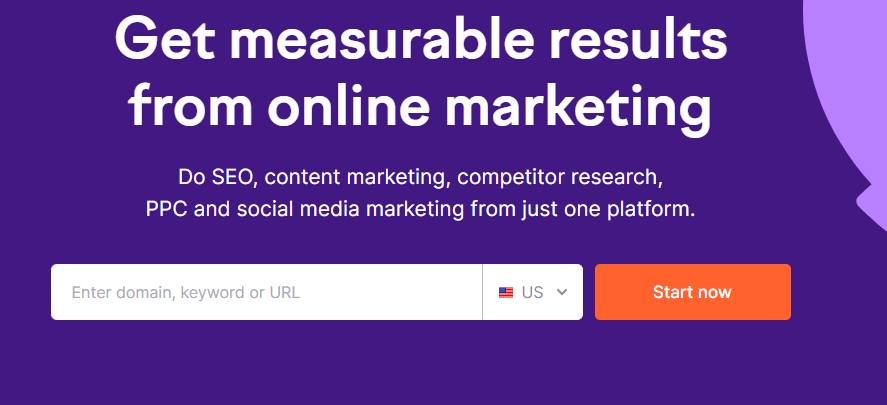Semrush vs. Ahrefs: Which is better?
Semrush and Ahrefs are effective and reliable SEO tools, but which is better depends on your business’s unique needs. Typically, Semrush is considered the better tool because of its larger database, broader features (like for advertising, content creation, and social media marketing), and pricing model.
When it comes to search engine optimization (SEO) tools, Semrush and Ahrefs are some of the most popular, offering users an A-Z toolkit for optimizing their site’s SEO. If you’re like most businesses, purchasing both doesn’t make sense. That’s why we’re breaking down Semrush vs. Ahrefs.
Is Semrush or Ahrefs better?
Semrush and Ahrefs are effective and reliable SEO tools, but which is better depends on your business’s unique needs. Typically, Semrush is considered the better tool because of its larger database, broader features (like for advertising, content creation, and social media marketing), and pricing model.
Learn the basics of Semrush and Ahrefs
Learn more about Semrush and Ahrefs before diving into our comparison:
What is Semrush?
Semrush is a paid marketing software that includes toolkits for SEO, social media, paid advertising, and content marketing. Businesses use Semrush for keyword research, competitor analysis, content creation, and more.

What is Ahrefs?
Ahrefs is a paid SEO tool (though verified site owners can access a free version of Ahrefs) focusing on on-page, off-page, and technical SEO. Businesses use Ahrefs for keyword research, competitor analysis, website maintenance, content optimization, and more.

What is the difference between Semrush and Ahrefs?
The main difference between Semrush and Ahrefs is Semrush is a marketing software while Ahrefs is an SEO tool. Additional differences include their pricing model and databases. Ahrefs pricing uses a paid subscription plus credits (many users are not a fan of this!) while Semrush pricing uses a paid subscription plan with optional add-ons. Semrush has a larger database than Ahrefs, though the two are very comparable.
Compare Ahrefs and Semrush
Compare Ahrefs and Semrush below:
| Area | Ahrefs | Semrush |
| Cost | Paid subscription, plus credit system | Paid subscription, plus optional add-ons |
| Toolkits | SEO | SEO Local SEO Social media Paid advertising Content marketing |
| Customer support | Help center Online chat |
Help center Online chat Phone |
| Usability | Easier to learn | Harder to learn |
| Reviews | Pros User-friendly interface Active community Educational resources Cons Pricing model Limited local SEO data Data refresh times |
Pros Comprehensive toolkit Regular updates Large database Cons Learning curve Plan limitations Speed |
| Website audit | Site health score Prioritized issues Issue descriptions Custom segments Audit history |
Site health score Prioritized issues Crawl comparison Multiple export options |
| Rank tracking | Keyword tags Competitor comparison Google Search Console integration |
Keyword tags Competitor comparison Cannibalization health score Featured snippet tracking Mobile app Algorithm update position tracking |
| Competitor analysis | Backlinks Traffic Keywords Paid keywords Changes over time |
Backlinks Traffic Keywords Paid keywords Changes over time Competitor lists |
| Backlink analysis | Referring domains Referring IPs Backlink gap Top anchor text URL rating (Ahrefs metric) |
Referring domains Referring domain categories Backlink gap Top anchor text Authority Score (Semrush metric) |
| Keyword research | Keyword metrics (volume, competition, and cost per click) Keyword gaps Keyword lists Custom keyword metrics (Ahrefs value, Ahrefs traffic potential) |
Keyword metrics (volume, competition, and cost per click) Keyword gaps Keyword lists |
Alternatives to SEMRush and Ahrefs
- Moz – one of the first SEO tools in the industry
- Screaming Frog – a desktop tool for onpage SEO analysis
- Google Search Console – Google provided tool for indexing and search reports
Generate Keyword Ideas in Seconds

Is Semrush missing what you need for SEO? Check out our complete list of Ahrefs alternatives, then!
How to choose between Ahrefs vs. Semrush
Now that you’ve viewed our Ahrefs and Semrush comparison, you can start thinking about which is right for you. When choosing a paid SEO tool, there are a few considerations — especially if you’re selecting a tool for your team vs. yourself, considering Moz alternatives like Ahrefs or Semrush could be beneficial.
Here are our tips for choosing between Ahrefs vs. Semrush:
1. Outline your requirements
Start by outlining your requirements, like the following:
- Budget
- Capabilities, like keyword research and SEO audits
- Access, like if multiple users will use the same account or one account per user
Reference your requirements against Semrush’s and Ahrefs’ pricing plans. Depending on your budget and required capabilities, one tool might be the only option. For example, if you want a tool that can assist with content, you’ll likely lean towards Semrush since Ahrefs doesn’t have a content toolkit.
P.S. If neither meets your needs, check out our comparison of Ahrefs vs. SpyFu.
2. Build your score sheet
Next, create a score sheet based on your needed capabilities, like keyword research.
The purpose of this sheet is to provide you and your team a place to store your thoughts on each tool’s features, like keyword research or SEO audits. This sheet can also keep you accountable for explaining why you liked or disliked a feature vs. saying you “just didn’t like it.”
3. Test your options
Finally, you can start testing your options.
With Semrush, you’ll have access to a free seven-day trial. In comparison, Ahrefs provides a freemium version of its software for verified site owners. You’ll need to review each tool’s pricing plans to determine the package you need to evaluate.
You may need to sign up for a paid plan depending on your needs.
If you’re disappointed with both, consider Moz Pro — and explore its pros and cons in our breakdown of Moz Pro vs. Ahrefs or in our breakdown of Moz vs. Semrush.
4. Choose your SEO tool
Once you and your team have some hands-on experience with Semrush and Ahrefs, you can rate your experiences. Based on your reviews, you can decide whether to purchase a full-time subscription to either of these tools or rethink your options.
If that’s the case, check out our other comparisons, like Semrush vs. SpyFu.
Which will you choose — Semrush or Ahrefs?
When it comes to Semrush or Ahrefs there is no correct answer. Even our team has different preferences for these SEO tools! Luckily, both offer the option to preview them for free, which you can use to familiarize yourself with their offerings.
Writers

Related Resources
- How to Use Moz for SEO: 5 Awesome Features
- How to Use Screaming Frog for SEO: the 2025 Guide
- Keyword Generator
- List of Great Firefox Plugins for SEO
- SEO Tools
- Shopify SEO Apps: Are They Worth It?
- The 11 Best Digital Marketing Tools in 2025
- The 15 Best Technical SEO Tools for Your Business
- The 7 Best Off-Page SEO Tools in 2025 [Free and Paid]
- What is an SEO Score? Definition, Factors, and How to Improve
-
Read Now
Ahrefs and Moz Pro are renowned SEO tools, with Ahrefs excelling in keyword research and backlink analysis, and Moz Pro offering robust website analytics, though both have been criticized for their complexity and pricing.
-
Read Now
With shared capabilities for keyword research, competitor analysis, and backlink analysis, whether you choose Ubersuggest vs. Semrush will depend on your SEO experience and business size.
-
Read Now
Ahrefs and Ubersuggest include keyword and content research, competitor and backlink analysis, and site auditing, with Ahrefs excelling in keyword research and competitor analysis, and Ubersuggest offering a user-friendly interface.
-
Read Now
Top SEO rank tracking tools like SEMrush, Ahrefs, Mangools, SE Ranking, and SEO Powersuite are crucial for monitoring your pages’ position in SERPs, analyzing keyword performance, and more! Learn more about these tools below!




